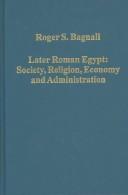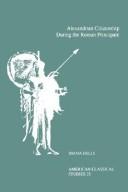| Listing 1 - 10 of 26 | << page >> |
Sort by
|
Book
ISBN: 9783447068925 3447068922 Year: 2013 Volume: 61 Publisher: Wiesbaden Harrassowitz
Abstract | Keywords | Export | Availability | Bookmark
 Loading...
Loading...Choose an application
- Reference Manager
- EndNote
- RefWorks (Direct export to RefWorks)
Egypt --- Egypte --- History --- Congresses --- Antiquities --- Histoire --- Congrès --- Antiquités --- Méditerranée (région) --- Rome --- Égypte --- Antiquities. --- 30 B.C.-640 A.D. --- Egypt. --- Congrès --- Antiquités
Book
ISBN: 9788864535395 Year: 2017 Publisher: Firenze Firenze University Press
Abstract | Keywords | Export | Availability | Bookmark
 Loading...
Loading...Choose an application
- Reference Manager
- EndNote
- RefWorks (Direct export to RefWorks)
Book
ISBN: 9783110571868 Year: 2019 Publisher: Brill De Gruyter
Abstract | Keywords | Export | Availability | Bookmark
 Loading...
Loading...Choose an application
- Reference Manager
- EndNote
- RefWorks (Direct export to RefWorks)
This book has a double purpose: to edit, using papyri in the Austrian National Library, a municipal archive of Hermoupolis Magna known only by the handwritten transcriptions of C. Wessely in 1905 (Stud. Pal. V) without translation or commentary; and to reveal, using this firsthand source from an Egyptian metropolis with close ties to the emperor Gallienus, the contrasted situation between 264 and 268, just before his assassination.
Antiquities. --- Manuscripts, Greek (Papyri) --- Manuscripts, Greek (Papyri). --- Österreichische Nationalbibliothek --- Österreichische Nationalbibliothek. --- 30 B.C.-640 A.D. --- Egypt --- Egypt. --- Hermopolis Magna (Extinct city) --- Rome (Empire). --- Rome --- History --- Sources.
Book
ISSN: 21903646 ISBN: 9783447069816 3447069813 Year: 2014 Volume: 9 Publisher: Wiesbaden Harrassowitz
Abstract | Keywords | Export | Availability | Bookmark
 Loading...
Loading...Choose an application
- Reference Manager
- EndNote
- RefWorks (Direct export to RefWorks)
Inscriptions, Egyptian --- Names, Geographical --- Egypt --- Idfū (Egypt) --- History --- Antiquities --- Inscriptions, Egyptian - Catalogs --- Names, Geographical - Egypt --- Egypt - History - 30 B.C.-640 A.D. --- Idfū (Egypt) - Antiquities
Book
ISBN: 9781108953948 9781108844901 9781108949002 1108844901 1108949002 1108953948 1108957129 1108957323 Year: 2021 Publisher: Cambridge, United Kingdom ; New York, NY : Cambridge University Press,
Abstract | Keywords | Export | Availability | Bookmark
 Loading...
Loading...Choose an application
- Reference Manager
- EndNote
- RefWorks (Direct export to RefWorks)
"As Ruler of the Two Lands, Egypt's pharaoh wore the double pschent crown: the red crown of Lower Egypt, in the north, surrounding the white crown of Upper Egypt, in the south. Personified in the ruler, this union remained a central ideal throughout Egyptian history. The unity of Upper and Lower Egypt, also symbolized in the knot tied between papyrus and reed, was long seen as key to Egypt's success. (Fig. 1.1.1) In practice, however, the country was diverse in many ways, with an ongoing struggle between the central ideologies of unity and uniformity and the realities on the ground. Egypt was a self-consciously distinctive culture that also constantly received and absorbed immigrants from many countries into its society"--
Romans --- Egypt --- History --- Période gréco-romaine (Egypte antique ; 332 av. J.-C.-640) --- Romanisation --- Römerzeit --- Égypte --- Ägypten --- HISTORY / Ancient / General --- Romans. --- 30 B.C.-640 A.D. --- Egypt.
Book
Year: 1891 Publisher: Lipsiae : B.G. Teubner,
Abstract | Keywords | Export | Availability | Bookmark
 Loading...
Loading...Choose an application
- Reference Manager
- EndNote
- RefWorks (Direct export to RefWorks)
Droit romain. --- Politics and government. --- Roman law. --- Roman law. --- 30 B.C.-640 A.D. --- Egypt --- Egypt. --- Égypte --- Politics and government --- Politique et gouvernement

ISBN: 0860788997 Year: 2003 Volume: CS758 Publisher: Aldershot Ashgate
Abstract | Keywords | Export | Availability | Bookmark
 Loading...
Loading...Choose an application
- Reference Manager
- EndNote
- RefWorks (Direct export to RefWorks)
Ancient history --- Egypt --- Egypte --- History --- Economic conditions --- Social conditions --- Politics and government --- Religion --- Histoire --- Conditions économiques --- Conditions sociales --- Politique et gouvernement --- Social conditions. --- Religion. --- Conditions économiques --- 30 B.C.-640 A.D.

ISBN: 1555405266 1555405258 Year: 1991 Volume: 23 Publisher: Atlanta, GA : Scholars Press,
Abstract | Keywords | Export | Availability | Bookmark
 Loading...
Loading...Choose an application
- Reference Manager
- EndNote
- RefWorks (Direct export to RefWorks)
Citizenship --- Nationalité --- History --- Histoire --- Alexandria (Egypt) --- Alexandrie (Egypte) --- Politics and government --- Administration --- -Birthright citizenship --- Citizenship (International law) --- National citizenship --- Nationality (Citizenship) --- Political science --- Public law --- Allegiance --- Civics --- Domicile --- Political rights --- Law and legislation --- -Egypt --- -Citizenship --- -History --- -Political science --- Birthright citizenship --- Nationalité --- Egypt --- Iskandarīyah (Egypt) --- Alexandrie (Egypt) --- Aleksandriyah (Egypt) --- Alessandria (Egypt) --- Alexandreia (Egypt) --- Aleksandria (Egypt) --- Alexantreia (Egypt) --- Alesandriʼa (Egypt) --- الإسكندرية (Egypt) --- الإسكندرية (مصر) --- اسكندرية (Egypt) --- Politics and government. --- 30 B.C.-640 A.D. --- Citizenship - Egypt - Alexandria - History. --- Alexandria (Egypt) - Politics and government. --- Egypt - Politics and government - 30 B.C.-640 A.D. --- History.
Book
ISBN: 9780979975820 0979975824 Year: 2011 Volume: 50 Publisher: Durham, N.C. : American Society of Papyrologists,
Abstract | Keywords | Export | Availability | Bookmark
 Loading...
Loading...Choose an application
- Reference Manager
- EndNote
- RefWorks (Direct export to RefWorks)
This volume, which replaces Girgi's outdated prosopography from 1938, is an annotated record of every person attested in the Byzantine-era papyri from the middle Egyptian village of Aphrodito.
Prosopography --- Prosopographie --- Aphrodito (Extinct city) --- Egypt --- Kom Ishgaw (Egypte) --- Egypte --- Biography --- Dictionaries --- History --- Biographies --- Dictionnaires anglais --- Histoire --- History. --- Methodology --- Aphroditopolis (Ancient city) --- Aphroditopolis (Sūhāj, Egypt : Extinct city) --- Antiquities --- Prosopography. --- 30 B.C.-640 A.D. --- Geschichte 400-700. --- Kom Ishgaw (Égypte) --- Égypte --- Egypt. --- Kawm Ishqâw. --- Kom Ischqau. --- Histoire.
Book
ISSN: 01699601 ISBN: 9789004250888 9004250883 1299691021 9004251308 9789004251304 9781299691025 Year: 2013 Volume: 32. Bd. Publisher: Leiden Brill
Abstract | Keywords | Export | Availability | Bookmark
 Loading...
Loading...Choose an application
- Reference Manager
- EndNote
- RefWorks (Direct export to RefWorks)
In Foreigners and Egyptians in the Late Egyptian Stories Camilla Di Biase-Dyson applies systemic functional linguistics, literary theory and New Historicist approaches to four of the Late Egyptian Stories and shows how language was exploited to establish the narrative roles of literary protagonists. The analysis reveals the shifting power dynamics between the Doomed Prince and his foreign wife and the parody in the depiction of the Hyksos ruler Apophis and his Theban counterpart Seqenenre. It also sheds light on the weight of history in the sketch of the Rebel of Joppa and the general Djehuty and explains the interplay of social expectations in the encounters between the envoy Wenamun and the Levantine princes with whom he seeks to trade. 'Overall, Di Biase-Dyson’s monograph is an original interdisciplinary examination of an exciting corpus of ancient literary texts.' Nikolaos Lazaridis, Journal of Near Eastern Studies
Egyptian literature. --- Egyptian language --- Littérature égyptienne --- Egyptien (Langue) --- Papyri, Hieratic. --- Papyrus hiératiques --- Egypt --- Egypte --- History --- Histoire --- Egyptian literature --- Hieratic writing --- Manuscripts, Hieratic (Papyri) --- Ancient Egyptian literature --- Egyptian language - Papyri, Hieratic --- Egypt - History - 30 B.C.-640 A.D.
| Listing 1 - 10 of 26 | << page >> |
Sort by
|

 Search
Search Feedback
Feedback About UniCat
About UniCat  Help
Help News
News